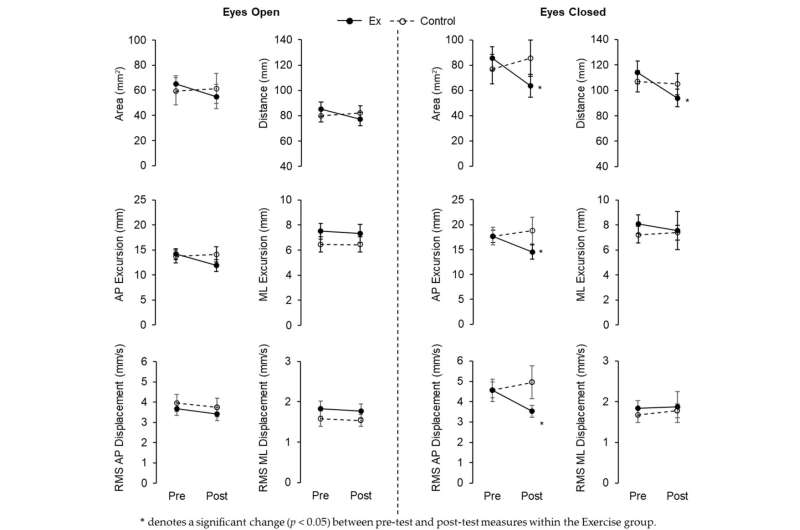This article has been reviewed according to Science X's editorial process and policies. Editors have highlighted the following attributes while ensuring the content's credibility:
fact-checked
peer-reviewed publication
trusted source
proofread
How sensory information affects posture, balance and movement

The domino effect of how your body operates is a mystifying, but fascinating area of study. The question of "why does this happen when I do that?" generates a never ending search for answers within the College of Education & Human Sciences (COEHS.)
UNM Athletic Training Associate Professor Daisuke Shibata is looking into just one of these aspects of cause and effect: posture and balance. His new research was just published in Symmetry.
"I want to understand how human beings use sensory information to create a movement. We have to understand what kind of sensory receptors we use in our body, and how we integrate sensory information with motion," Shibata said.
It's especially prevalent in Shibata's field—the more he learns, potentially, the better our bodies play and feel.
"We want to figure out what kind of system we use inside our body to maintain balance," he said. "Like once an individual got injured, what kind of functions would be impaired? What kind of intervention may be helpful to recover from the injury?"
Working with UNM HSC Orthopedics & Rehabilitation Assistant Professor Yuri Yoshida, Shibata combined neuroscience, movement and health.
"The knowledge and concept of motor control and neuroscience must be used in our athletic training education because when it comes to rehabilitations of balance in an injured individual, we have to enhance the function of sensory-motor integration to provide better balance," Shibata said.
Understanding these connections begins with the concept of sensory-motor integration. Humans will use feeling, this sensory experience, to create a movement. That's the case no matter what we are doing.
"Sensory-motor integration must be used in any human activity," Shibata said. "For example, when you have the input from your hand, it's when you touch something or you grab something. When you grab the water bottle, you feel the pressure, you feel the weight, and then you have to produce an appropriate amount of force."
So how do humans register when their balance is off? Shibata asked this, as well as how they adjust their posture, and know when to, when that feeling is understood.
"If you change body posture, how do we react? How does our body react to the changes in posture? I'm also working on how we walk in response to changes in posture," he said.
For the study, Shibata recruited 32 young, healthy participants to North Campus, and its motion capture system, once a week for three weeks.
While one group performed specific motions on a foam roller, lying down, another group simply laid flat on the ground. After that, they stood still for 10 seconds for several times on a sensor, while Shibata measured sway.
"It's similar to when you stand on a scale, but with a pressure sensor. We look at how much force is distributed under the feet, between left and right foot, front to back and so on," he said.
Participant sway and wobbles were also evaluated as they stared ahead at a fixed point, or closed their eyes.
"I'm looking at simple balance, which is just standing still. The activity used in research helps us understand how we use sensory information to maintain balance. I also manipulate the sensory information by changing posture," he said.
It's a lot of little factors that can add up to a big change. Still, since human beings are not a one-size-fits-all in research implications, it's about the why.
"The human body is not symmetrical. It is not perfect, and it is okay to be different," Shibata said. "More importantly, from my perspective, is how to accommodate and adjust to differences to maintain balance and to prevent falling."
Knowing there is some connection, then, between what goes on inside your head and how you move, does not answer the longstanding debate of what "proper" posture is.
"There are processes and procedures to improve posture. It's true we need to stretch some muscles and engage in activities, but what is proper posture, is not really understood at this moment," Shibata said. "One with proper posture may not be proper posture for you, so I think it is very important to understand who you are. Each individual is different. Even if you have bad posture, you may be good at balancing."
Still, these efforts in Athletic Training could have a critical impact on helping injuries, or preventing them in elderly folks.
"Sensory-motor integration will be compromised by aging, injury and cognitive functions. So understanding how we maintain balance will be influenced by posture. Conversely, if we improve posture, we may be able to maintain balance," Shibata said.
More information: Daisuke Shibata et al, Self-Mobilization Exercise Program Improved Postural Stability in the Anterior-Posterior Direction with Eyes Closed, Symmetry (2023). DOI: 10.3390/sym15071321





















